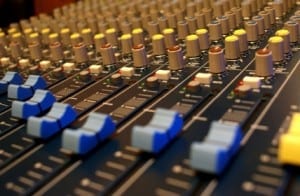Recording and Engineering Techniques from ‘Random Access Memories’ by Daft Punk
Daft Punk has always been on the cutting edge of EDM, and in fact their records from the late 90's and early 2000's pretty much define what we know as the genre today. So it was somewhat surprising when the press from the group’s most recent album, Random Access Memories , revealed that the secretive and strangely private French group was going with a back-to-basics approach which saw them relying less on computers and more on analog equipment and real instruments.

Whether you like the new album or not (and most critics and music fans alike do, it would seem), the group must be commended for taking what at first glance seems like a step back, but may in fact be more of a step forward for the genre. Sonicscoop.com interviewed Mick Guzauski, the engineer for the record, who revealed a wealth of information about the recording and engineering process for Random Access Memories .
It’s hard to believe the guy Daft Punk chose to engineer their 2013 record has a resume that includes Kenny Rogers, Barbra Streisand and Chuck Mangione. But it was because of his eclectic resume that the group became interested in working with him, and Guzauski also mixed the record. His mixing background includes work with Talking Heads, Prince, Andrew Lloyd Webber, Luther Vandross and many more.
Guzauski also was surprised to get the call from Daft Punk, but said he soon saw what he could do to help the duo achieve their vision.
“I had heard what their other albums were like, and I thought, ‘This is really cool, but why are they calling me?’ I didn't have a lot of experience in electronica,” he said. “Then we talked, and they said they wanted a retro album going back to ‘70’s disco, with all live players. The idea was electronica based on live performances. I thought, ‘This is going to be great,’ and I got excited.”
The album was tracked in Los Angeles at Conway Recording’s Studio C, which is a large and “live” sounding room. Perhaps surprisingly, most of the basic tracks on the album were recorded live, and Guzauski says drums, bass, grand piano, Fender Rhodes and synths were often recorded at the same time. He also said that percussionist Quinn was overdubbed, in large part because he had a huge, self-built drum and instrument kit that had “an amazing sound” that often sounded more like psychedelic noises than percussion.
Back to the sound Daft Punk was going for with the record, Guzauksi sums it up better than most reviews that have tried, and he also gives insight into how a recording space can affect the final product.
“They just wanted the sound to be very natural,” he said. “Think 1970’s when things were not very processed, but think hi-fi too – modern quality, but natural sounds. The drums we tracked were baffled off. Studio C is fairly live, but we also had room mics. We could get tight sounds if we wanted, but also use the room.
“At this point in the project, I didn't know what was going where, so I wanted to track with the flexibility of using different acoustic perspectives later on. Most of the drums are dry and tight for the dance songs, but for parts of “Touch” it’s almost all room. We tried to record with versatility in mind.”




